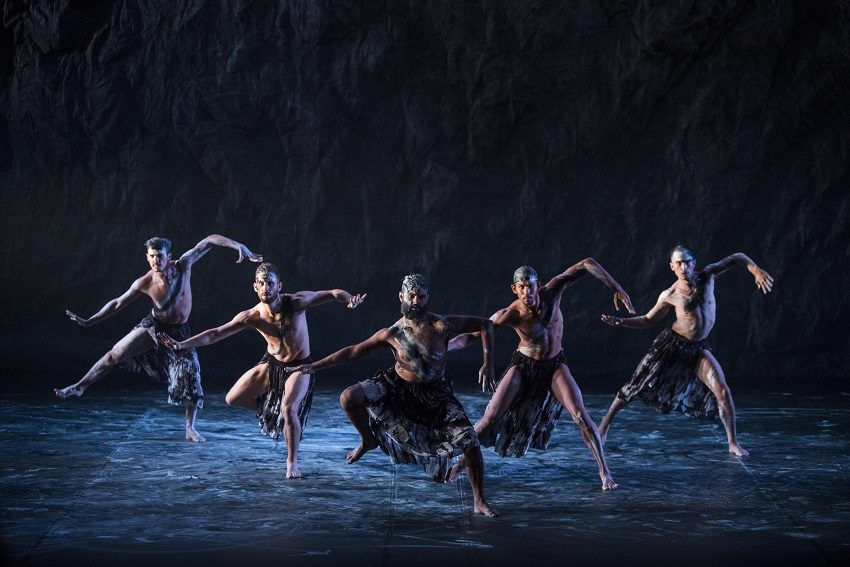Review: Bangarra Dance Theatre: 30 Years of Sixty Thousand

Bangarra Dance Theatre celebrates its 30th anniversary by bringing an intoxicating sample of work to Adelaide for an evening of dance that draws inspiration from David Unaipon and millennia of First Nations culture.
What a joy it is to celebrate Bangarra Dance Theatre’s 30 years! Their program is called 30 Years of Sixty Thousand and includes two complete works and excerpts from several others. The first half of the program is given to Frances Rings’ Unaipon, which premiered in 2004. David Unaipon is the man on the $50 note. A Ngarrindjeri man from South Australia, he was born in 1872 at Raukkan Mission and died in 1967. When he was 13 he went to live for five years with a white family in Adelaide, studied and became interested in philosophy, astronomy, science, literature and music. He continued studying when he returned to Raukkan and over the next 35 years he invented several devices, including a modified handpiece for shearing. A stickler for good English, he wrote articles and columns for newspapers and gathered Aboriginal myths and legends for publication.
From this fascinating man’s life Rings drew a work which is not so much about his life as a meditation on his life and work. It begins with Unaipon philosophising on our place in the universe but moves on to an intriguing dance sequence based on traditional string games – making cats’ cradles – but here four men tumble in at the ends of rubber strands which they form into geometrical shapes, the white-lit strands stretched across the stage, stark against the black background. A well-structured sequence interpreting perpetual motion follows, developing through straight lines, the intense dancers walking, accelerating, spinning and turning.
The last part, danced to Allegri’s Miserere, expresses Unaipon’s belief that ‘in Jesus Christ colour and racial distinction disappeared’. The men and women are dressed in white shirts and light trousers, until the men leave and then return shirtless, a strikingly visual symbolic effect. The choreography, with much floor work including headstands, works surprisingly well, achieving a grave elegance.

Jiri Kylián’s Stamping Ground is the first work by a non-Indigenous artist to be presented by Bangarra, and resulted from Kylián’s strong interest in dance as being central to Aboriginal life. In 1980 he came to Australia to observe it at first hand, and he and some colleagues gathered over 1000 Top End Aboriginal people together for a week on Groote Island for a highly unusual corroboree. The large work that was intended to result did not eventuate. Instead we have a sparkling choreography for three women and three men which impregnates western dance with suggestions of Aboriginal gestures and dance movements. It is quirky, witty, sharp and engaging.
Beginning with one woman entering an empty stage, it develops as a series of encounters and solos, enlivened by clever lifts. At first Stamping Ground is danced in silence except for the sounds of the dancers’ feet and body slaps, then a drumbeat begins, a Toccata by Carlos Chávez. The ensuing combination of movement and percussion becomes almost intoxicating.
The third piece, To Make Fire, is an anthology of excerpts from several Bangarra works, beginning with Mathinna, based on the fate of an Aboriginal girl taken into a white family but later rejected, and then rejected once more upon trying to return to her own people. It had a powerful performance by Lillian Banks in the title role, Tara Gower and Rikki Mason. Elma Kris’s About took as its subject ‘the cultural connection between the people of the Torres Strait Islands and the spirits of the four winds’. Last on the program, Clan drew from Rush and ID, ending with the light of dawn rousing the cast from dreaming – a singularly beautiful image.
The dancing of the whole company is notable, but special mention must be made of Tyrel Dulvarie in Unaipon and Stamping Ground and Rika Hamaguchi in Stamping Ground.
Altogether, a most satisfying performance.
30 Years of Sixty Five Thousand was performed on 19 September
Bangarra Dance Theatre
30 Years of Sixty Five Thousand
Dunstan Playhouse
19-21 September